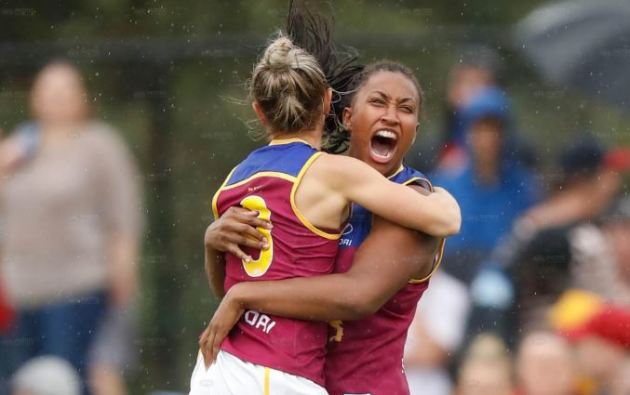
The inaugural AFLW season has exceeded the expectations of sports sponsorship agents and the competition's official broadcaster, but the real test will now be sustaining first season momentum to grow the game.
The competition produced average crowds of 7,000 and free-to-air viewership on par with the bigger WBBL games.
In the first weekend, the four games broadcast had a national reach of 2.6 million viewers, with the match between Carlton and Collingwood attracting an average metro audience of 593,000. The first game of the season was so popular that fans were locked out after the 24,000 seat Ikon Park reached capacity well before kick off.
Ratings on Seven's coverage fell away in subsequent weeks but still maintained a metro average of just above 270,000 over eight games, fuelled by strong interest in Melbourne (accounting for an average of 211,000).
Fox Sports attracted an average of 64,040 across its 25 games. The grand final between eventual champions Adelaide and Brisbane attracted a metro audience of 360,000.
Seven's network director of sports sales Patrick Moloughney recently told AdNews interest in the women’s game has even given the code more talkability and a longer lead in period to engage the corporate sector in the lead up to the men's footy season.
Moloughney adds that the women's game has not only attracted new fans, but also brought new brands to the sport.
Exceeded expectations
Gemba Goup head of strategy for Asia-Pacific, Craig Roberts, tells AdNews the level of interest, media coverage and positivity around the AFLW certainly exceeded his expectations.
“Whether or not it’s bringing significant new sponsorship money into the industry just yet, brands have certainly been willing to align with the AFLW at both League and club level,” he says
“For a new competition, it’s difficult to know what success really looks like and the real test will be sustaining momentum into future seasons. But overall, the attendances and ratings have been similar to the WBBL in its launch season.”
That said, Roberts points out that in reality the AFLW is not a mass reach proposition in the way the traditional, established sports properties are.
“But it’s an opportunity for some brands that might not typically be associated with sport, or men’s sport in particular, to align their brands with sport and tap into the passionate audiences that sport brings,” he adds.
“There’s also positive sentiment around being early backers and supporters of elite women’s sport, so for brands like NAB who took a bit of a risk in sponsoring a new property, they can use AFLW to help position themselves as innovators and active supporters of female athletes and competitions. This in turn helps to build their corporate social responsibility footprint as underwriters of a new national competition.”

A 'watershed' year
In a comment piece for AdNews today, The Bastion Collective CEO Jack Watts believes the past year has been a watershed moment for women's sport and “savvy sponsors” are now expanding their remit to include women's teams as well as men.
Aside from NAB, Holden sponsors both Collingwood teams and Visy and Hyundai sponsor both Carlton teams.
“Women’s sport is also attracting new sponsors, including blue-chip companies such as Priceline (AFL), Nissan (grassroots netball league), and Suncorp (Suncorp Super Netball league),” Watts adds.
Then there's the likes of global insurer Aon, which has signed on as a shirt sponsor of women's rugby and as a naming sponsor of a new universities competition while Rebel has heavily backed women's Big Bash League.
“Over the next three years, we will see the industry consolidate as it continues its upward trajectory,” adds Watts, who's firm helps brands plan and execute sports sponsorship.
“With major sponsors on board and multi-year broadcasting deals in place, women’s sport will go from strength to strength. My tip for big brands wanting to invest is women’s sport grassroots leagues – this is the major growth opportunity for 2017-18.”

An 'arms race'
Although the AFLW had a great opening season, the code won't have it its own way. More than 100,000 attended the second season of the Women’s Big Bash League, with another 1.5 million watching online.
While for the first round of the Suncorp Super Netball, 19,559 spectators were in attendance and 850,000 watched all four games at peak viewership.
“Our research shows that interest in the AFLW overall is in line with the other major national women’s competitions – netball and cricket. Interest in AFLW is higher than in the W-League soccer and the WNBL basketball league,” Roberts points out.
“Among AFL fanatics, about 38% are very interested in the AFLW. and I’m sure the AFL will be hoping that more of their core fan base convert their interest across to the women’s competition next year.
The real test will come in the second season to see if the AFLW can maintain or broaden interest levels or whether it will drop away as the novelty factor wears off.
This will require an investment in female talent pathways to improve the depth and quality of the game.
“It’s created a bit of an arms race and a battle for talent for elite female athletes. And it’s brought a lot of attention to women’s sport more broadly which can only help to grow the category.”
Have something to say on this? Share your views in the comments section below. Or if you have a news story or tip-off, drop us a line at adnews@yaffa.com.au
Sign up to the AdNews newsletter, like us on Facebook or follow us on Twitter for breaking stories and campaigns throughout the day.


